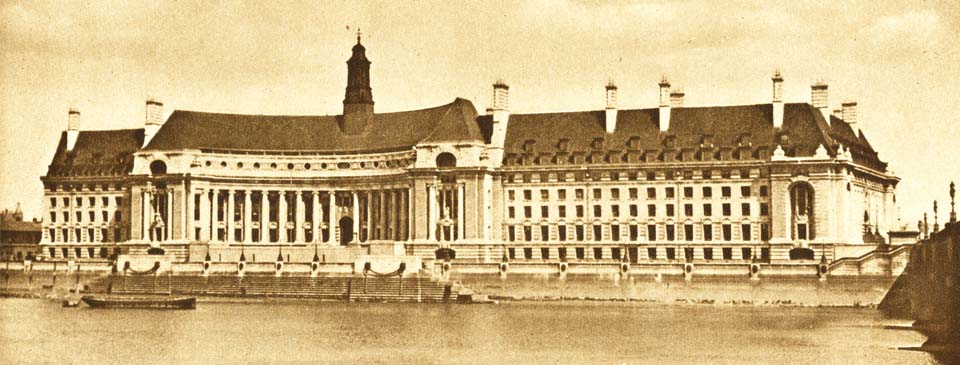In brief – Early-20th century London

County Hall, offices of the London County Council, opened in 1922 on the south side of Westminster Bridge. At that time it was unfinished, hence its lack of symmetry in this photograph. It was built on the site of the earlier Metropolitan Board of Works offices and various wharves and factories. It served as the headquarters of local London government until 1986.
During the Victorian period London had undergone a great deal of modernization, clearing away old districts and buildings and replacing with new, creating suburbs where there had previously been fields or mixed-use land. That process continued at the beginning of the 20th century. The first four decades saw rebuilding on an unprecedented scale, the greatest physical change to London since the rebuilding after the Great Fire in the 17th century. Buckingham Palace, the Mall and Whitehall were transformed and a large area of slums were cleared away to form Aldwych and Kingsway.
London had always been a cosmopolitan city. In 1911 about four percent of the population had been born abroad. During the latter part of the 19th century the biggest single group of foreigners were the German community. Such was the rapid influx of Yiddish-speaking East European Jews during the last decade of the 19th century that they quickly outnumbered the Germans to become the largest group of immigrants in London. The area around Whitechapel became a Jewish ghetto where they established their own shops, synagogues, entertainments and employment. More continued to arrive in large numbers in the first years of the 20th century but the influx slowed after the passing of the Aliens Act in 1905.
Poor planning and mass immigration during the previous century created a shortage of quality accommodation for the working classes in the inner London boroughs. Typical accommodation for most working-class families was two rooms and a kitchen but many lived in a single room housing several people. Even in the late 1930s many households lacked their own piped water, having instead to use a shared standpipe and an outside toilet. Social housing for the working-classes had been started in central districts at the end of the 19th century by several wealthy philanthropists and continued in the first half of the 20th by the LCC. During the 1920s they began to create completely new planned towns, the earliest of which was on green fields at Beacontree. Large numbers of new social-housing estates were built during the 1930s and at the end of the decade there were about 190 LCC estates. By then about six percent of London’s population was living in affordable local authority accommodation, mostly of a reasonable standard.
The health of Londoners during the first half of the century generally greatly improved compared with the previous century. On the whole people were better-off financially, with most families having at least one breadwinner, or in a worst-case at least claiming unemployment benefit. Older people were able to collect old-age pension. All children were attending school, with lunchtime meals provided. Subsequently Londoners were on the whole better clothed and fed than previously, living in homes that were heated in winter. By the 1920s it was unusual to find bare-footed and malnourished children on London’s streets as had still been the case prior to the First World War.
The change from horsepower to motor vehicles came rapidly in London. At the outbreak of the First World War in 1914 horse-drawn vehicles were still in the majority. By its end horse-drawn hansom cabs had all but disappeared and in 1930 the majority of vehicles were powered by mechanical means. The second, third and fourth decades saw the building of modern new dual-carriage arterial roads in order to both increase the speed of traffic and create employment: the North Circular Road, Great West Road, Great Cambridge Road, Eastern Avenue, and various local bypasses. These new roads further encouraged ribbon development of housing and industry.


